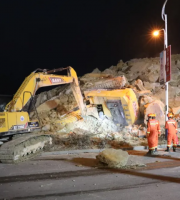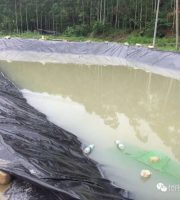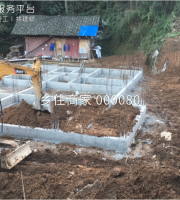(1) Add water at will during construction
.
Article 7.5.2 of GB / t14902-2012 ready mixed concrete clearly stipulates that “the mixer truck shall drain the ponding in the mixing tank before loading, and it is strictly prohibited to add water to the concrete in the mixing tank after loading”
.
Some construction workers ignore this provision and use water pipes to add water to the pump bucket or tank barrel without permission in order to facilitate pumping and reduce the resistance of leveling; What’s more, regardless of the dryness and thinness of the incoming materials, put on the water pipe and pour while adding water
.
Adding water to the concrete mixture will increase the water binder ratio of the concrete
.
The greater the water binder ratio, the lower the final strength of the concrete
.
If too much water is added, the strength of the concrete will not meet the design requirements and cannot pass the acceptance
.
Finally, it will be remedied by reinforcement
.
In serious cases, it will even be pushed over and over again
.
This has caused great losses to construction enterprises
.
Therefore, the national standard clearly stipulates that it is strictly prohibited to add water to the concrete mixture
.
When the slump of the concrete mixture is too small, the tank truck driver can add an appropriate amount of admixture to adjust the slump according to the technical disclosure of his company, so as to facilitate pumping construction( 2) For ultra-high pouring and delayed vibration, it is clearly stipulated in article 6.6.9 of gb50164-2011 concrete quality control standard that “when pouring structures with large vertical dimensions, it shall be poured in layers, and the pouring thickness of each layer should be controlled at 300 ~ 350mm; And more vibrating rods can be arranged, which should be vibrated while pouring concrete, and should be formed continuously “
.
In some construction sites, the floor is 1.5m, and even when the wall and beam slab are poured at the same time, the wall is poured to the top of the slab at one time
.
Some constructors have no experience in pumping concrete pouring
.
Regardless of whether the front pouring personnel can catch up with the rear vibrating personnel, the result is that there are few vibrating rods and the vibration speed is slow, resulting in the widening distance between pouring and vibration
.
In addition, the pouring temperature is high, resulting in the rapid collapse of concrete poured into the formwork
.
When vibrating after pouring for 20min, The concrete is not easy to vibrate, and holes will be left after the vibrator is pulled out
.
Only then did we know to stop the front pouring work
.
After formwork removal, holes, exposed reinforcement or honeycomb pitted surface appear in many parts of the wall in this section
.
Super high pouring is easy to cause formwork expansion
.
If it cannot be vibrated with pouring, it is easy to form cavities, exposed reinforcement and honeycomb and pitted surface
.
When pouring the wall within 3M, it can be divided into two layers
.
If the workability of pumped concrete is good and it is easy to vibrate and compact, the layer height can be increased to 1000 ~ 150mm
.
When the vibration speed cannot keep up with the pouring speed, the pouring shall be stopped immediately and the pouring shall be started when the vibration personnel keep up( 3) The waiting time of concrete on the construction site is too long
.
According to article 6.6.14 of gb50164-2011 concrete quality control standard, the duration from the discharge of concrete mixture from the mixer to the completion of pouring shall not exceed the provisions in table 6.6.14
.
That is, when the temperature is ≤ 25 ℃, the duration should not exceed 150 minutes; When the temperature is higher than 25 ℃, the duration should not exceed 120min
.
When pouring structural columns or secondary structures on the construction site, it often takes more than 180 minutes, even more than 300 minutes
.
Especially in summer, it is not easy to pour concrete for more than 3H
.
It is better to pour concrete after thinning with admixture; Some construction sites directly add water to dilute and then continue pouring, which is bound to cause insufficient concrete strength
.
The solution is that when planning to pour sporadic works, the site materialman shall determine the transportation volume of each vehicle according to the pouring speed and the duration specified in the standard, rather than excessive transportation in one vehicle, resulting in overtime pouring( 4) The curing of concrete after pouring is too poor
.
Article 7.4.7 of GB50204 code for acceptance of construction quality of concrete structures stipulates: “the concrete shall be covered and moisturized within 12 hours after pouring; When the watering method is adopted, the watering times shall be able to keep the concrete surface wet, which shall not be less than 7d; For the concrete cured with plastic cloth, all exposed surfaces shall be covered tightly, and there shall be condensate in the plastic cloth; Before the concrete strength reaches 1.2MPa, it is not allowed to install formwork or lift heavy reinforcement, pipe support and other heavy objects “
.
Some construction units do not assign special personnel to maintain concrete, and even individual units do not maintain concrete structural columns and shear walls at all
.
The author once participated in the rebound of a C25 structural column
.
The rebound age is 29d and the pouring date is April
.
The rebound strength is less than 20MPa, and the carbonation depth reaches 7mm
.
A few units can’t cover the cast-in-situ concrete slab with plastic cloth for maintenance in time, resulting in irregular cracks in the concrete in the early stage
.
Most construction units have poor maintenance for the part above 20 floors of high-rise buildings, so the degree of concrete maintenance can be seen from the carbonation depth measured at the rebound strength
.
The cementitious material in concrete is hydraulic, and the concrete can only be hydrated in a humid environment after forming; Otherwise, the faster the water loss in the concrete, the worse the hydration of cementitious materials, and the greater the loss of concrete strength
.
Therefore, the newly poured concrete must be cured in strict accordance with the requirements of specifications and procedures
.
Before the strength of the cast-in-situ concrete slab reaches 1.2MPa, it is not allowed to hoist bundled reinforcement, pipe rack or heavy large steel formwork
.
Otherwise, it is easy to cause cracks in cast-in-situ slab due to the impact load of hoisting( 5) Formwork removal is too early
.
In order to catch up with the construction period, some construction sites remove the wall column formwork the next morning after pouring the concrete the night before
.
When the temperature is normal, it is OK, but in case of cooling weather, it is too early to remove the formwork the next morning because the concrete has not yet set
.
If the formwork is removed too early, there will be formwork peeling or horizontal cracks along the stirrup (horizontal reinforcement)
.
This is caused by the sinking of the concrete due to its own weight
.
Therefore, before removing the formwork, you must first check whether the concrete is finally set, and it is appropriate to scratch the top surface of the concrete with your fingernails without loose mortar, otherwise you can’t remove the formwork
.
Article source: for talent recruitment in the online concrete industry, you can also find a small editor to contribute / apply for certificates / insurance / talk about concrete
.
Now long press identification to add it!.
.



